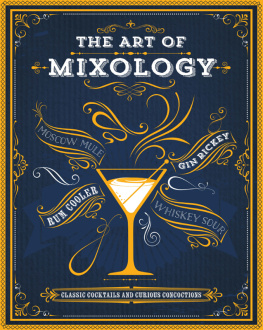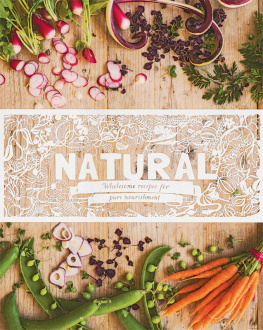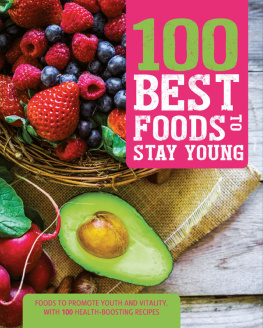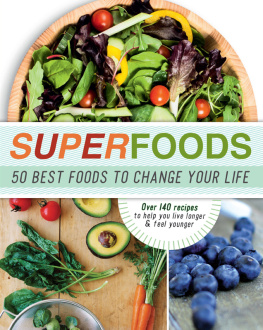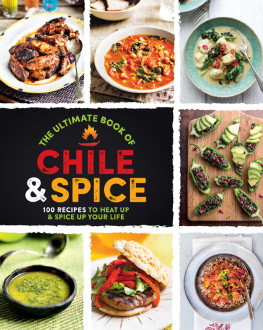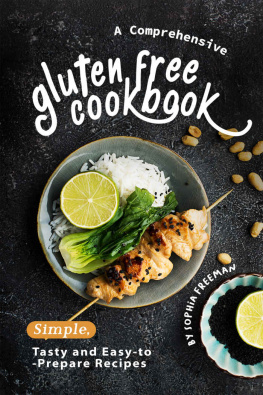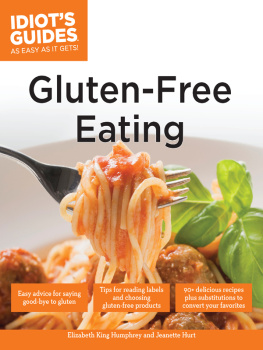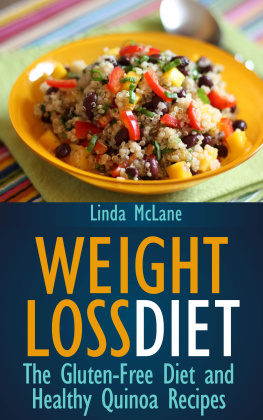
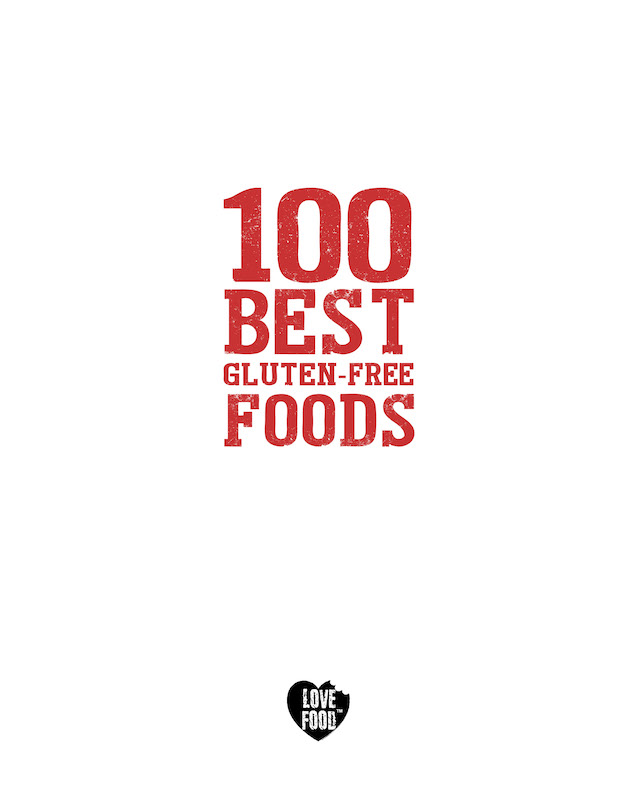
This digital edition first published by Parragon Books Ltd in 2014 and distributed by
Parragon Inc.
440 Park Avenue South, 13th Floor
New York, NY 10016
www.parragon.com/lovefood
LOVE FOOD is an imprint of Parragon Books Ltd
Copyright Parragon Books Ltd 2014
LOVE FOOD and the accompanying heart device is a registered trademark of Parragon Books Ltd in the USA, the UK, Australia, India, and the EU.
All rights reserved. No part of this publication may be reproduced, stored in a retrieval system, or transmitted, in any form or by any means, electric, mechanical, photocopying, recording, or otherwise, without the prior permission of the copyright holder.
10 9 8 7 6 5 4 3 2
ISBN 978-1-4723-8478-2
Created and produced by made-to-measure-books
New photography by Clive Streeter
Nutritional consultant: Judith Wills
Nutritional data obtained from the USDA national nutrient database.
Notes for the Reader
This book uses standard kitchen measuring spoons and cups. All spoon and cup measurements are level unless otherwise indicated. Unless otherwise stated, milk is assumed to be whole, eggs are large, individual vegetables are medium, and pepper is freshly ground black pepper. Unless otherwise stated, all root vegetables should be peeled prior to using.
Garnishes, decorations, and serving suggestions are all optional and not necessarily included in the recipe ingredients or method. The times given are only an approximate guide. Preparation times differ according to the techniques used by different people and the cooking times may also vary from those given. Optional ingredients, variations, or serving suggestions have not been included in the time calculations.
While the author has made all reasonable efforts to ensure that the information contained in this book is accurate and up to date at the time of publication, anyone reading this book should note the following important points:
Medical and pharmaceutical knowledge is constantly changing and the author and the publisher cannot and do not guarantee the accuracy or appropriateness of the contents of this book.
In any event, this book is not intended to be, and should not be relied upon, as a substitute for appropriate, tailored professional advice. Both the author and the publisher strongly recommend that a healthcare practitioner is consulted before making major dietary changes.
For the reasons set out above, and to the fullest extent permitted by law, the author and publisher: (i) cannot and do not accept any legal duty of care or responsibility in relation to the accuracy or appropriateness of the contents of this book, even where expressed as advice or using other words to this effect; and (ii) disclaim any liability, loss, damage, or risk that may be claimed or incurred as a consequencedirectly or indirectlyof the use and/or application of any of the contents of this book.
CONTENTS
INTRODUCTION
Celiac diseasean autoimmune disease that causes the body to produce antibodies to react to glutenaffects around 1 in 100 people throughout the world. The only cure is to avoid gluten completely. For life. Gluten is one of the proteins found in wheat, barley, and rye, and it is also in many processed foods, but, thankfully, there is no need to feel deprived when you are on a gluten-free diet. With a little know-how, you can have a varied, nutritionally balanced, and enjoyable diet.
Celiac disease damages the small Intestine and can result in unpleasant symptoms, such as nausea, bloating/gas, diarrhea, and constipation, which can be debilitating. The resulting damage to the intestine causes malabsorption of nutrients, leading to other symptoms, such as tiredness, headaches, canker sores, hair loss, anemia, osteoporosis, and weight loss, so it is important that it is properly diagnosed. Anyone recently diagnosed with celiac disease needs as nutritious and beneficial a diet as possible, because they may have been experiencing poor nutrient absorption for some time.
Some people who dont have celiac disease also follow a gluten-free diet, and the number of those who want to cut gluten from their diet is increasing. These people may experience bloating, gas, indigestion, and irritable bowel syndrome, for example, and feel a gluten-free diet helps minimize these symptoms. Or it may be a personal choice, because they may simply feel more healthy on a gluten-free diet.
As well as being in wheat, barley, and rye, gluten is also found in many processed foods that contain small amounts of these grains and their by-products. Some people are also sensitive to avenin, a protein similar to gluten found in oats. Many oats may also be contaminated with gluten because they are packaged in the same factories as wheat, barley, or rye, so most celiacs avoid oats, too. Look for oats labeled as gluten-free if you still want to include them in your diet.
Foods to avoid on a gluten-free diet
The most obvious foods that may contain gluten are those that normally contain wheat, such as breads, crackers, breakfast cereals, pasta, flour, pastry, cakes, and cookies. Many other foods contain wheat, rye, or barley in smaller amounts; for example, breaded and battered fish and nuggets, beverages such as beer, desserts, confectionery, packaged and canned soups and stocks. This isnt a comprehensive list. For more information, contact a support organization (such as Celiac.com) for details of foods that contain gluten and those that are gluten-free, as well as to learn about new gluten-free labeling information.
Food choices on a gluten-free diet
There are many choices of grains and pseudo grains that do not contain gluten and many of these, such as quinoa, teff, amaranth, rice, and buckwheat, are actually richer in health-protecting and health-promoting nutrients.
As well as these great gluten-free grains, there is also a wide choice of other naturally gluten-free foods to provide carbs in your diet. Legumes (beans, lentils, and split peas) are rich in starch and come with higher levels of many of the vitamins and minerals, too. Several vegetables are high-carbfor example, sweet potatoes, parsnips, and beetsand these offer additional health benefits because most are rich in phytochemicals. Research into these plant chemicals shows that they are important in helping to prevent our most prevalent diseases and many health problems associated with aging. Other vegetables and some fruits are useful sources of carbohydrates, so there is plenty of choice.
There is much benefit in choosing a diet that is basically natural instead of highly processed. The natural foods highlighted in this book dont come with long ingredients lists that you need to check for gluten, and are probably more nutritious. However, supermarkets are stocking more and more ingredients and processed foods that are gluten-free items. Gluten-free pastas, breads, crackers, and cereals can add variety and convenience to your diet.
Get plenty of vitamins and minerals
There are several key nutrients that people following a gluten-free diet often lack: Vitamins A, B1, B2, niacin, folate, B12, D, E, and K and the minerals calcium, iron, magnesium, phosphorous, and zinc.
By choosing a wide range of foods from this book to eat regularly, you will almost certainly get your recommended daily allowances of vitamins and minerals, as well as all the other nutrients and compounds we need for health. For example, a mix of gluten-free grains and legumes will provide carbs, protein, folate, and magnesium in abundance; fruit and vegetables are packed with phytochemicals, potassium, and vitamin C and leafy greens are rich in vitamin K. Nuts and seeds are rich in unsaturated fats and zinc, while meat provides high-quality protein, iron, phosphorous, and the B vitamins. From eggs we get vitamins A, D, and E; from fish and shellfish selenium and omega-3 fats; and from yogurt and cheese, calcium. And, of course, all these foods contain many other nutrients, too.



